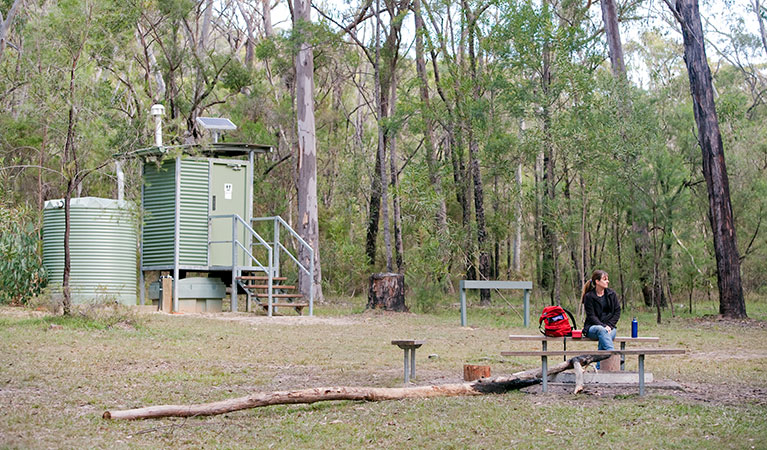Ten Mile Hollow campground
Dharug National Park
Overview
Set up your tent and relax at remote Ten Mile Hollow, in Dharug National Park. Only accessible by walking or cycling, it's a beautifully tranquil rest stop on the multi-day Old Great North Road hike.
| Number of campsites | 6 |
|---|---|
| Camping type | Tent, Remote/backpack camping |
| Where | Simpsons Track, Ten Mile Hollow, NSW, 2250 - in Dharug National Park |
| Facilities | Barbecue facilities, toilets |
| What to bring | Drinking water, cooking water, firewood |
| Price | There are no camping fees at this campground but a $6 booking fee applies. |
| Bookings | Book up to 12 people or 2 sites online. |
| Group bookings | This campground is not suitable for group bookings. |
| Please note |
|
Ten Mile Hollow campground is a great place to stop overnight when you’re walking the multi-day walk along the World Heritage-listed Old Great North Road.
Accessed by foot or bike only, this basic campground is bound to be a welcome sight after a day spent walking or cycling. Ease your tired legs and enjoy a campfire and dinner, ready for a good sleep and another day of exploring this rugged park.
Map
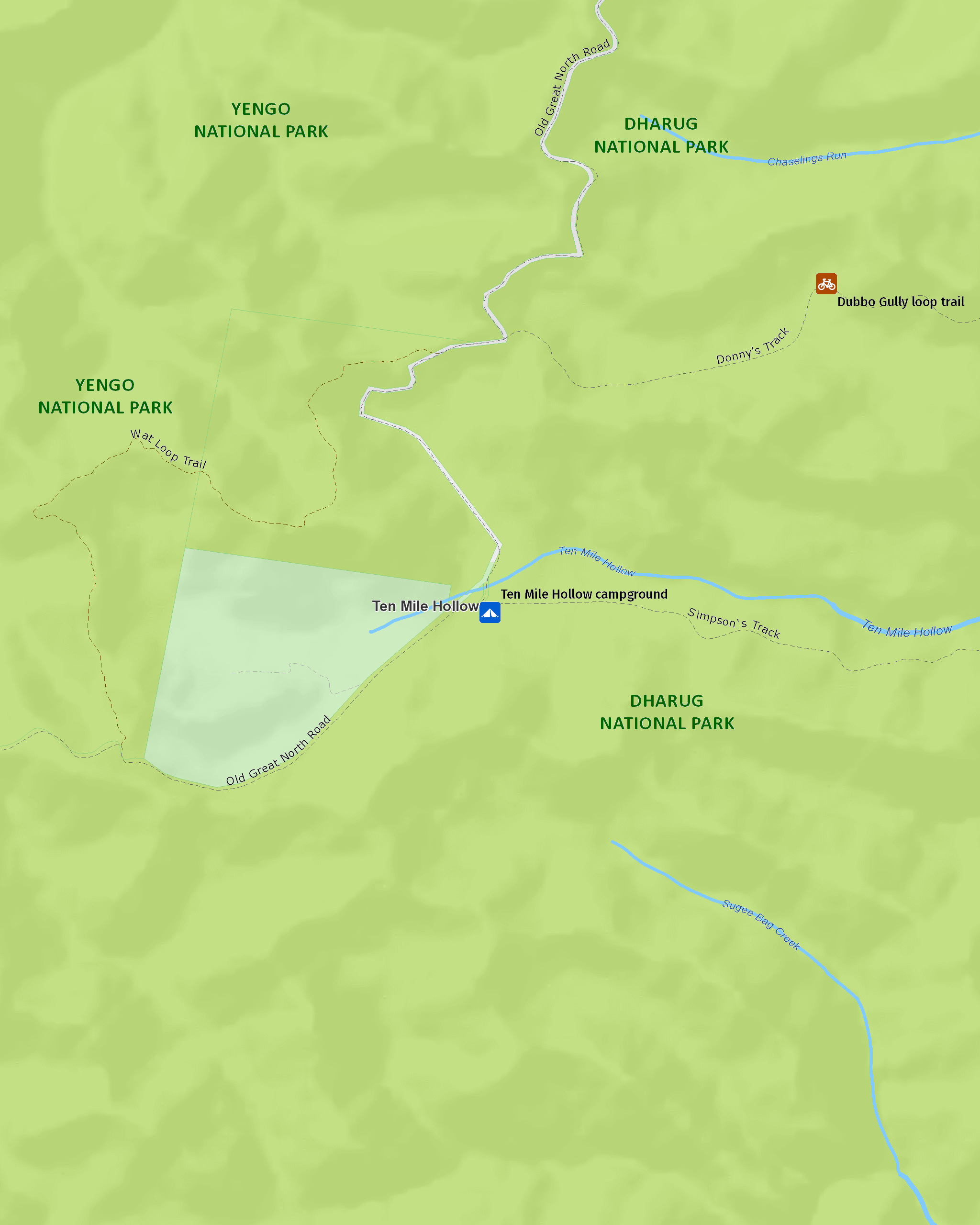
Map legend

Local alerts
For the latest updates on fires, closures and other alerts in this area, see https://uat.nswparks.cloud/camping-and-accommodation/campgrounds/ten-mile-hollow-campground/local-alerts
Bookings
- National Parks Contact Centre
- 7am to 7pm daily
- 1300 072 757 (13000 PARKS) for the cost of a local call within Australia excluding mobiles
- parks.info@environment.nsw.gov.au
Operated by
- Bulga office
- Monday to Friday, 9.30am to 4pm.
- 02 6574 5555
- npws.wollemiyengo@environment.nsw.gov.au
- 2156 Putty Road, Bulga NSW 2330
Park info
- in Dharug National Park in the Sydney and surrounds region
Dharug National Park is always open but may have to close at times due to poor weather or fire danger.
Visitor info
All the practical information you need to know about Ten Mile Hollow campground.
Maps and downloads
Learn more
Ten Mile Hollow campground is in Dharug National Park. Here are just some of the reasons why this park is special:
Aboriginal heritage
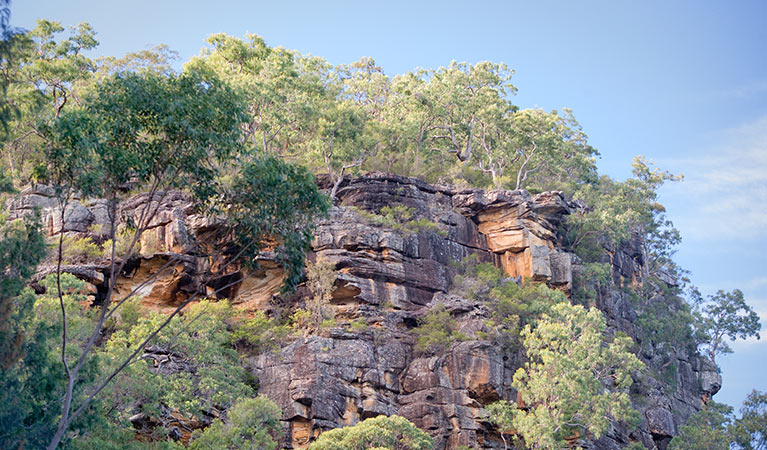
Dharug National Park is the traditional Country of the Dharug Aboriginal people. Abundant in animal, plant and bird life, the area was a rich source of food, medicines and shelter. The park's diverse landscapes and all they contain feature in all aspects of Aboriginal culture and are associated with Dreaming stories and cultural learning that is still passed on today.
Rugged beauty
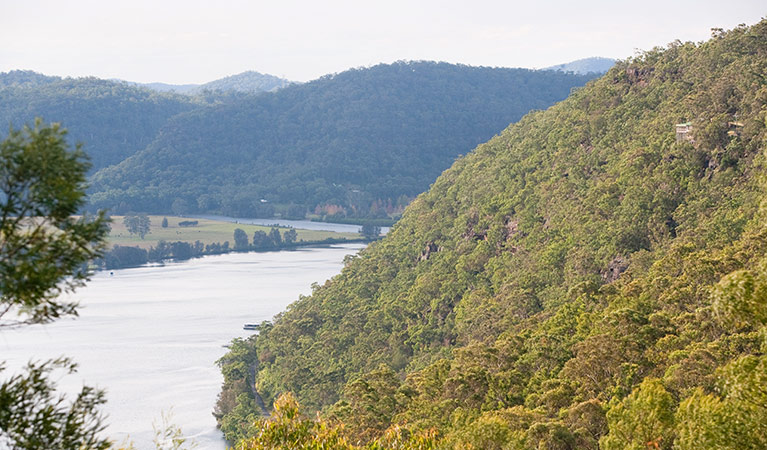
From the rugged bushland containing gang-gang cockatoos, satin bowerbirds and Lewin's honeyeaters to the sparkling waters of the creeks and the rich colours of the sandstone cliffs and formations, Dharug National Park offers a diverse range of landscapes. Bring your bike, bushwalk, camp by the creek, canoe on the Hawkesbury or make the most of the backdrop with your camera, there is so much to explore.
Step into Australia’s past
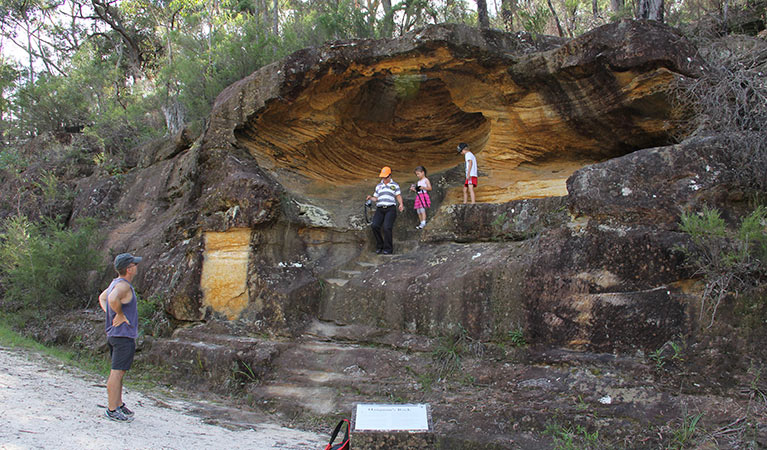
Dharug National Park contains the Old Great North Road, one of 11 historic sites which form the Australian Convict Sites World Heritage property. It's a spectacular example of early colonial engineering and demonstrates the use of convict labour; up to 720 convicts - some in chains - worked on the road, which spanned 264km, connecting Sydney to the settlements of the Hunter Valley. Only 43km of the road remains relatively intact, running from Wisemans Ferry in the south to Mount Manning in the north and includes the oldest surviving stone bridges in mainland Australia. It makes a great walk to explore over two or three days or an exhilarating day's cycle.
- Devines Hill loop Head to Devines Hill loop in Dharug National Park, near Wisemans Ferry this weekend for a bike ride or walk along the historic World Heritage-listed Devines Hill loop.
- Old Great North Road - World Heritage walk Old Great North Road – World Heritage walk highlights a historic convict-built road with scenic river views, via Finchs Line, in Dharug National Park.
Plants and animals protected in this park
Animals
-

Superb lyrebird (Menura novaehollandiae)
With a complex mimicking call and an elaborate courtship dance to match, the superb lyrebird is one of the most spectacular Australian animals. A bird watching must-see, the superb lyrebird can be found in rainforests and wet woodlands across eastern NSW and Victoria.
-

Australian brush turkey (Alectura lathami)
The Australian brush turkey, also known as bush or scrub turkey, can be found in rainforests along eastern NSW. With a striking red head, blue-black plumage and booming call, these distinctive Australian birds are easy to spot while bird watching in several NSW national parks.
-

Bare-nosed wombat (Vombatus ursinus)
A large, squat marsupial, the Australian bare-nosed wombat is a burrowing mammal found in coastal forests and mountain ranges across NSW and Victoria. The only other remaining species of wombat in NSW, the endangered southern hairy-nosed wombat, was considered extinct until relatively recently.
-

Lace monitor (Varanus varius)
One of Australia’s largest lizards, the carnivorous tree-dwelling lace monitor, or tree goanna, can grow to 2m in length and is found in forests and coastal tablelands across eastern Australia. These Australian animals are typically dark blue in colour with whitish spots or blotches.
Plants
-

Gymea lily (Doryanthes excelsa)
The magnificent Gymea lily is one of the most unusual Australian native plants, found only along the coast and surrounding bushland of the Sydney Basin, from Newcastle to Wollongong. In spring this giant lily shoots out spectacular red flowers that can reach heights of 2-4m.
Environments in this park
Education resources (1)
Bookings
- National Parks Contact Centre
- 7am to 7pm daily
- 1300 072 757 (13000 PARKS) for the cost of a local call within Australia excluding mobiles
- parks.info@environment.nsw.gov.au
Operated by
- Bulga office
- Monday to Friday, 9.30am to 4pm.
- 02 6574 5555
- npws.wollemiyengo@environment.nsw.gov.au
- 2156 Putty Road, Bulga NSW 2330
Park info
- in Dharug National Park in the Sydney and surrounds region
Dharug National Park is always open but may have to close at times due to poor weather or fire danger.
What's nearby:
Things to do (65)
- Aboriginal culture (10)
- Adventure sports (2)
- Beach (1)
- Birdwatching and wildlife encounters (16)
- Canoeing/paddling (4)
- Cultural heritage (2)
- Cycling (8)
- Environmental appreciation/study (1)
- Fishing (1)
- Geotourism (1)
- Historic heritage (11)
- Horse riding (3)
- Other experiences (2)
- Photography (2)
- Picnics and barbecues (7)
- Road trips and car/bus tours (1)
- Sailing, boating and cruises (3)
- Sightseeing (25)
- Snorkelling and scuba (1)
- Swimming (1)
- Walking (34)
- Waterfalls (5)
- Wildflowers (seasonal) (6)

